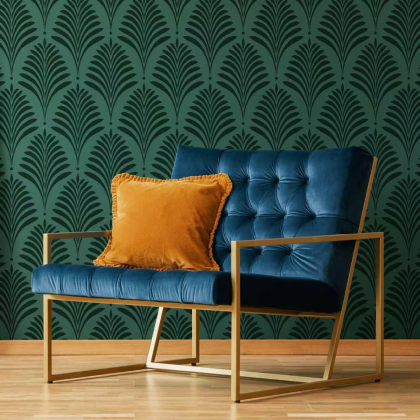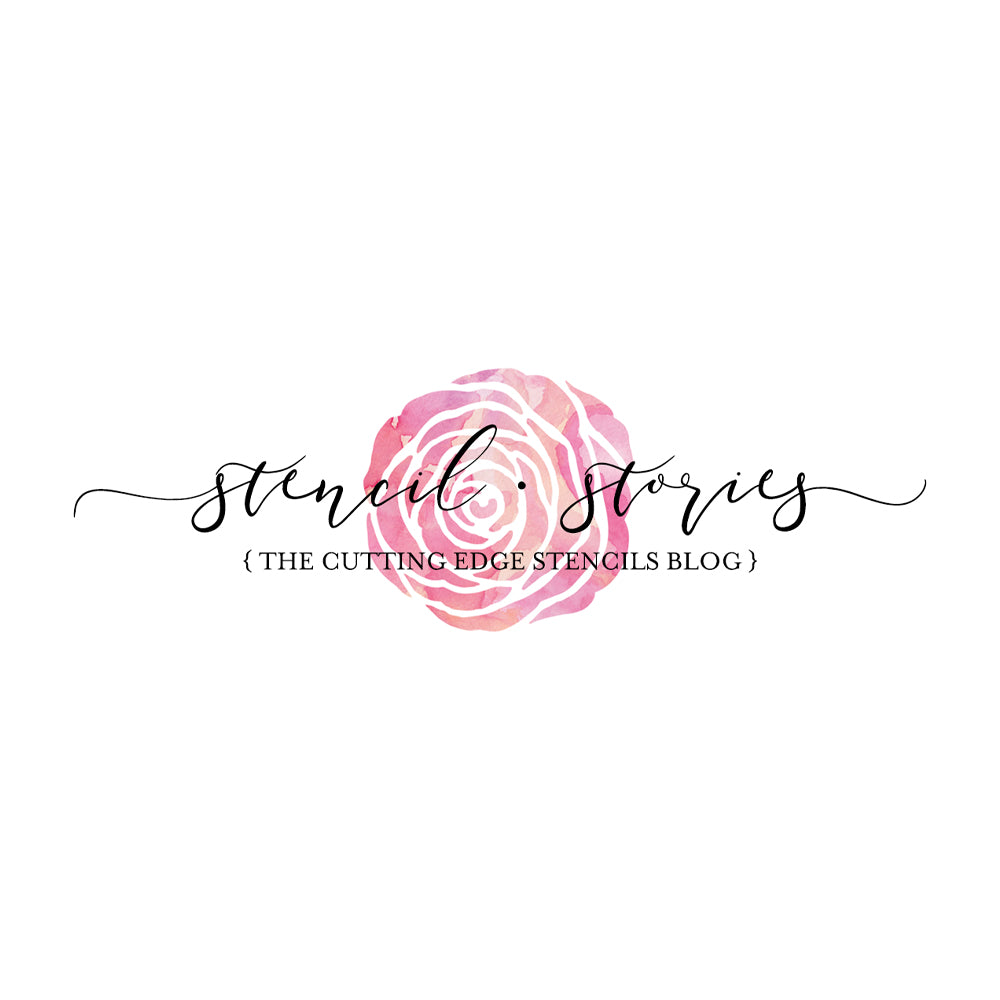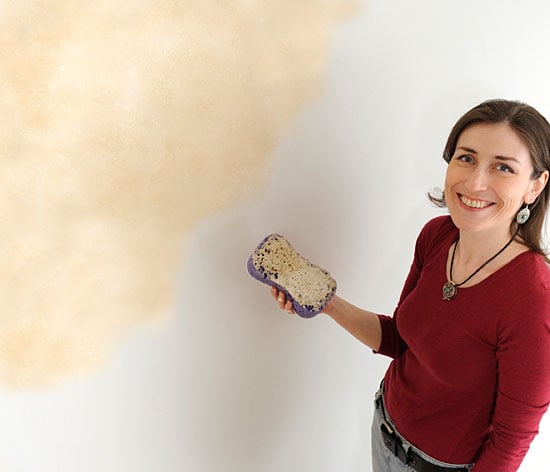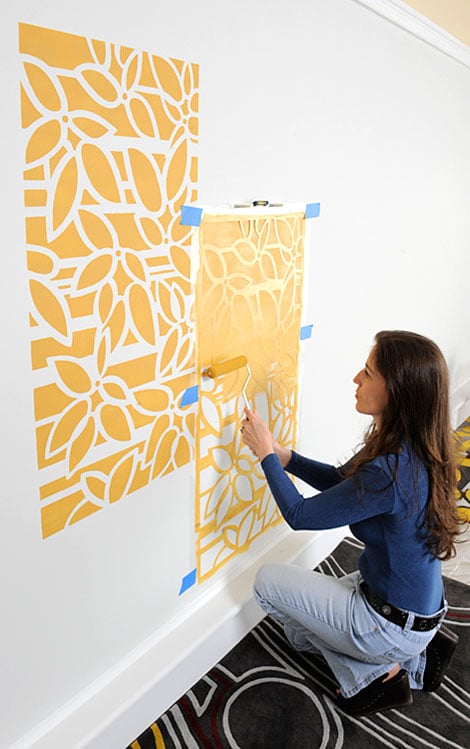Stenciling with stencil brushes
Stencils are perfect for DIY decor: easy, economical and fun! You can stencil with a roller or a stencil brush. Stenciling with
stencil brushes is somewhat slower than with a roller, but you can get really artsy with them and have more control.
For detailed, multicolored or shaded look it's best to use stencil brushes. I personally just love stencil brushes, that is where you get creative and experiment with color blending and shadowing. For
allover stencil patterns, such as damasks, I recommend using a
stencil roller. Some folks use stencil brushes for allovers, but those people must have infinite amount of time and patience...
This brush stenciling technique is surprisingly easy and takes very little time to learn.
I've talked about properly loading your stencil brush with paint in my previous post. Bottom line: use less paint and rub off most of it on a
folded paper towel.

First, secure the
stencil on your wall or other surface either with pieces of blue painter's tape or with spray adhesive. I like having all my acrylic colors on one foam plate. I squeeze a dollop of each acrylic color I am going to use around the perimeter of the plate leaving the middle empty for mixing colors. I also like to tape my folded paper towel right to to the wall next my stenciling, it's a very handy trick that often saves you trips up and down the ladder.

There are few ways in which you can apply paint with a stencil brush. The simplest is dabbing or pouncing motion. Start dabbing with your loaded (and then off-loaded on a paper towel)
stencil brush over the stencil design using a light touch. You can also try a light sweeping or circular motion, this way you can achieve a very delicate, almost an air-brushed look. Try to vary the force with which you dab or pounce, since it gives you different results and different paint coverage. The lighter you do it, the more light and translucent the coverage will be.


If you need to add another color, take a second stencil brush, load it with your new color and dab it over the parts of the
stencil design that need that color. Here for
Wisteria Border leaves, I am adding some olive green acrylic color.

Don't forget to always wipe the excess paint on the paper towel after each time you re-load your brush.

I love over- dabbing the previous color here and there with another color to get nice blended effects on my
stencil. Here I am adding some rust tones and yellow ochre acrylic to my green leaves. Don't be afraid to experiment with colors! It's really fun and easy! Sometimes adding an unusual color to your stencil work makes it really unique and beautiful. With
stencils, blending of colors is so incredibly easy.

Your color blending doesn't have to be perfect or very smooth. Stenciling is so forgiving, something that looks a bit messy on the
stencil surface will be absolutely perfect and crisp once you lift that stencil!

The design gets quickly covered with paint. Lift a corner, take a peek, if you like the way its going -put the corner back and keep stenciling until all of the stencil design gets a desired paint coverage and shading.

Look how crisp the edges are!

For each color take a separate
stencil brush... Yep, you'll need a separate brush for each color, although I always cheat and recycle the same brush by wiping it nicely on paper towels and then using it with a similar color. Do not recycle dark color brush for a light color, it's going to look dirty no matter how nicely you wiped it. I don't recommend washing the brush in the middle of the project because it will be too wet to use even if you dry it.


Now that the main colors are applied, it would be great to add some shading for some dimension. Shading is done by pouncing a dark color at the edges of stencil openings. This very simple touch gives you amazing depth and dimension.

Two tips: do not use black color for shading. Actually, there are no black shadows in nature, they all seem to have some color in them, thus shading in black will give you a stark, unnatural result. Much better to use Raw umber, or neutral dark brown color. Put a little bit of Raw Umber acrylics on your stencil brush and lightly dab the edges of stencil openings.
Second tip: don't just shade
all edges around each stencil opening, unless you're going for that "inflated balloon" look. Shadows in nature happen on some sides of objects while other sides stay light. They call it a light source. Simply decide which side of each element will stay light (that's where the light is hitting it) and shade only the opposite side of each element.
I often start shading on one side, then forget about the light source and shade the other side, and in the end it looks great anyway!

For the foliage I use simple rule: shade all leaf tips and all leaf bottoms. This gives a very realistic look and you dont have to think about a light source!

Remove the
stencil...

The result: beautiful multi-color Wisteria!

Now, let's connect some bridges using the watercolor brush. Not a necessary step, but surely adds to the "hand-painted" look of this
stencil design.

Final look: life-like wisteria vine border. How much time it took? About 20 minutes for this one. Fast, sin't it?

And for this project I didn't need any shading, since my goal was to quickly
stencil a butterfly using a single solid color and a brush. I was going for a complete opaque paint coverage, so I had a bit more paint on my brush and used a dabbing motion. I am using Benjamin Moore Aura paint - perfect paint when it comes to opacity, it covers in one coat even when using light colors over dark ones.


For this
Poppy Stripe stencil, I used 2 colors and 2 separate
stencil brushes. No shading was necessary, the goal was to get opaque solid coverage. Paint used: Benjamin Moore Aura.



So as you can see, stenciling with
brushes is a lot of fun and not difficult at all.
Stay tuned for more stenciling tips and tricks!
Janna
 First, secure the stencil on your wall or other surface either with pieces of blue painter's tape or with spray adhesive. I like having all my acrylic colors on one foam plate. I squeeze a dollop of each acrylic color I am going to use around the perimeter of the plate leaving the middle empty for mixing colors. I also like to tape my folded paper towel right to to the wall next my stenciling, it's a very handy trick that often saves you trips up and down the ladder.
First, secure the stencil on your wall or other surface either with pieces of blue painter's tape or with spray adhesive. I like having all my acrylic colors on one foam plate. I squeeze a dollop of each acrylic color I am going to use around the perimeter of the plate leaving the middle empty for mixing colors. I also like to tape my folded paper towel right to to the wall next my stenciling, it's a very handy trick that often saves you trips up and down the ladder.
 There are few ways in which you can apply paint with a stencil brush. The simplest is dabbing or pouncing motion. Start dabbing with your loaded (and then off-loaded on a paper towel) stencil brush over the stencil design using a light touch. You can also try a light sweeping or circular motion, this way you can achieve a very delicate, almost an air-brushed look. Try to vary the force with which you dab or pounce, since it gives you different results and different paint coverage. The lighter you do it, the more light and translucent the coverage will be.
There are few ways in which you can apply paint with a stencil brush. The simplest is dabbing or pouncing motion. Start dabbing with your loaded (and then off-loaded on a paper towel) stencil brush over the stencil design using a light touch. You can also try a light sweeping or circular motion, this way you can achieve a very delicate, almost an air-brushed look. Try to vary the force with which you dab or pounce, since it gives you different results and different paint coverage. The lighter you do it, the more light and translucent the coverage will be.

 If you need to add another color, take a second stencil brush, load it with your new color and dab it over the parts of the stencil design that need that color. Here for Wisteria Border leaves, I am adding some olive green acrylic color.
If you need to add another color, take a second stencil brush, load it with your new color and dab it over the parts of the stencil design that need that color. Here for Wisteria Border leaves, I am adding some olive green acrylic color.
 Don't forget to always wipe the excess paint on the paper towel after each time you re-load your brush.
Don't forget to always wipe the excess paint on the paper towel after each time you re-load your brush.
 I love over- dabbing the previous color here and there with another color to get nice blended effects on my stencil. Here I am adding some rust tones and yellow ochre acrylic to my green leaves. Don't be afraid to experiment with colors! It's really fun and easy! Sometimes adding an unusual color to your stencil work makes it really unique and beautiful. With stencils, blending of colors is so incredibly easy.
I love over- dabbing the previous color here and there with another color to get nice blended effects on my stencil. Here I am adding some rust tones and yellow ochre acrylic to my green leaves. Don't be afraid to experiment with colors! It's really fun and easy! Sometimes adding an unusual color to your stencil work makes it really unique and beautiful. With stencils, blending of colors is so incredibly easy.
 Your color blending doesn't have to be perfect or very smooth. Stenciling is so forgiving, something that looks a bit messy on the stencil surface will be absolutely perfect and crisp once you lift that stencil!
Your color blending doesn't have to be perfect or very smooth. Stenciling is so forgiving, something that looks a bit messy on the stencil surface will be absolutely perfect and crisp once you lift that stencil!
 The design gets quickly covered with paint. Lift a corner, take a peek, if you like the way its going -put the corner back and keep stenciling until all of the stencil design gets a desired paint coverage and shading.
The design gets quickly covered with paint. Lift a corner, take a peek, if you like the way its going -put the corner back and keep stenciling until all of the stencil design gets a desired paint coverage and shading.
 Look how crisp the edges are!
Look how crisp the edges are!
 For each color take a separate stencil brush... Yep, you'll need a separate brush for each color, although I always cheat and recycle the same brush by wiping it nicely on paper towels and then using it with a similar color. Do not recycle dark color brush for a light color, it's going to look dirty no matter how nicely you wiped it. I don't recommend washing the brush in the middle of the project because it will be too wet to use even if you dry it.
For each color take a separate stencil brush... Yep, you'll need a separate brush for each color, although I always cheat and recycle the same brush by wiping it nicely on paper towels and then using it with a similar color. Do not recycle dark color brush for a light color, it's going to look dirty no matter how nicely you wiped it. I don't recommend washing the brush in the middle of the project because it will be too wet to use even if you dry it.

 Now that the main colors are applied, it would be great to add some shading for some dimension. Shading is done by pouncing a dark color at the edges of stencil openings. This very simple touch gives you amazing depth and dimension.
Now that the main colors are applied, it would be great to add some shading for some dimension. Shading is done by pouncing a dark color at the edges of stencil openings. This very simple touch gives you amazing depth and dimension.
 Two tips: do not use black color for shading. Actually, there are no black shadows in nature, they all seem to have some color in them, thus shading in black will give you a stark, unnatural result. Much better to use Raw umber, or neutral dark brown color. Put a little bit of Raw Umber acrylics on your stencil brush and lightly dab the edges of stencil openings.
Second tip: don't just shade all edges around each stencil opening, unless you're going for that "inflated balloon" look. Shadows in nature happen on some sides of objects while other sides stay light. They call it a light source. Simply decide which side of each element will stay light (that's where the light is hitting it) and shade only the opposite side of each element.
I often start shading on one side, then forget about the light source and shade the other side, and in the end it looks great anyway!
Two tips: do not use black color for shading. Actually, there are no black shadows in nature, they all seem to have some color in them, thus shading in black will give you a stark, unnatural result. Much better to use Raw umber, or neutral dark brown color. Put a little bit of Raw Umber acrylics on your stencil brush and lightly dab the edges of stencil openings.
Second tip: don't just shade all edges around each stencil opening, unless you're going for that "inflated balloon" look. Shadows in nature happen on some sides of objects while other sides stay light. They call it a light source. Simply decide which side of each element will stay light (that's where the light is hitting it) and shade only the opposite side of each element.
I often start shading on one side, then forget about the light source and shade the other side, and in the end it looks great anyway!
 For the foliage I use simple rule: shade all leaf tips and all leaf bottoms. This gives a very realistic look and you dont have to think about a light source!
For the foliage I use simple rule: shade all leaf tips and all leaf bottoms. This gives a very realistic look and you dont have to think about a light source!
 Remove the stencil...
Remove the stencil...
 The result: beautiful multi-color Wisteria!
The result: beautiful multi-color Wisteria!
 Now, let's connect some bridges using the watercolor brush. Not a necessary step, but surely adds to the "hand-painted" look of this stencil design.
Now, let's connect some bridges using the watercolor brush. Not a necessary step, but surely adds to the "hand-painted" look of this stencil design.
 Final look: life-like wisteria vine border. How much time it took? About 20 minutes for this one. Fast, sin't it?
Final look: life-like wisteria vine border. How much time it took? About 20 minutes for this one. Fast, sin't it?
 And for this project I didn't need any shading, since my goal was to quickly stencil a butterfly using a single solid color and a brush. I was going for a complete opaque paint coverage, so I had a bit more paint on my brush and used a dabbing motion. I am using Benjamin Moore Aura paint - perfect paint when it comes to opacity, it covers in one coat even when using light colors over dark ones.
And for this project I didn't need any shading, since my goal was to quickly stencil a butterfly using a single solid color and a brush. I was going for a complete opaque paint coverage, so I had a bit more paint on my brush and used a dabbing motion. I am using Benjamin Moore Aura paint - perfect paint when it comes to opacity, it covers in one coat even when using light colors over dark ones.

 For this Poppy Stripe stencil, I used 2 colors and 2 separate stencil brushes. No shading was necessary, the goal was to get opaque solid coverage. Paint used: Benjamin Moore Aura.
For this Poppy Stripe stencil, I used 2 colors and 2 separate stencil brushes. No shading was necessary, the goal was to get opaque solid coverage. Paint used: Benjamin Moore Aura.


 So as you can see, stenciling with brushes is a lot of fun and not difficult at all.
Stay tuned for more stenciling tips and tricks!
Janna
So as you can see, stenciling with brushes is a lot of fun and not difficult at all.
Stay tuned for more stenciling tips and tricks!
Janna






